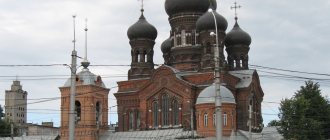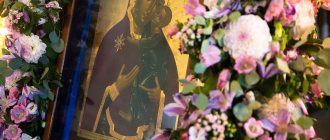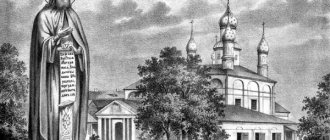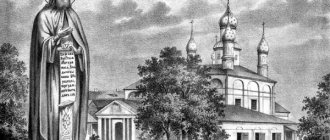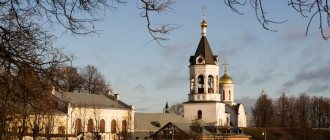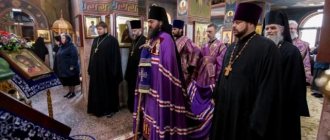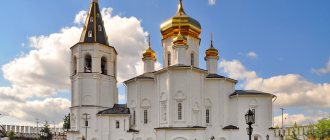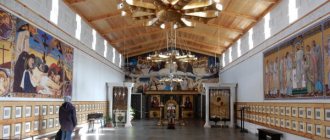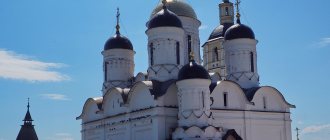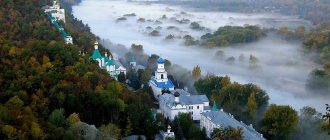The Tolgsky Monastery is one of the largest convents in Russia, and it was also the first monastery opened in Soviet times. Its history goes back more than 700 years, and the most amazing thing is that not only the buildings of the 17th–18th centuries have been preserved here, but also the main shrine of the monastery - the icon of the Tolga Mother of God, the patroness of the Yaroslavl land, famous for its numerous miracles.
The name of the monastery “Tolgsky” comes from the name of the Tolga river, which previously flowed into the Volga 10 km above Yaroslavl. The word “Tolga” itself translated from the Finno-Ugric language means “bird feather”.
Next to the Tolgsky Monastery there is a unique park made of Siberian cedar, which can only be visited with a guided tour. The air in the monastery is saturated with divinity and peace. It is undoubtedly worth coming to the Tolgsky Monastery; it is an incredibly beautiful place where we are filled with a special state of mind.
History of the Tolga Holy Vvedensky Monastery
Unfortunately, documentary information about the history of the monastery is fragmentary and scarce. You can learn about the events that took place within its walls, for the most part, in texts that describe the miraculous appearances of the famous Tolga icon.
Tolga Holy Vvedensky Monastery from the side of the pier
An ancient legend is associated with the foundation of the monastery. In August 1314, Bishop Trifon of Rostov, together with several Orthodox priests, traveled to Belozerye. Already on the way to Yaroslavl, they settled down for the night on the right bank of the Volga. At night, the bishop saw a wonderful dream about the appearance of an icon of the Mother of God. In the morning, on the other side of the river, in the forest, the servants found a wonderful icon.
Tryphon did not return to Yaroslavl. He ensured that a wooden church was built in memory of the miracle, which was consecrated in honor of the Leading of the Mother of God into the Temple. The found icon was moved here. Gradually a monastery was formed around the new temple. They began to call it Togskaya - after the river flowing into the Volga.
It is known that at the end of the 14th century there was a severe fire in the monastery. Many buildings and the fence of the monastery were burned. The first wooden temple also burned to the ground. The flames destroyed ancient books and all liturgical utensils, but the main monastery icon was saved. After the fire, benefactors helped rebuild the monastery, and monastic life continued. Many pilgrims always came here, and the Yaroslavl princes provided their patronage to the monastery. Thus, Prince Fyodor Fedorovich granted the village of Kukoltsyno to the monastery, and the peasants who lived there were freed from all princely duties and taxes.
Cathedral of the Entry into the Temple of the Blessed Virgin Mary (Vvedensky Cathedral) with a bell tower
The year 1553 is especially noted in the monastery chronicle. Tsar Ivan the Terrible came to the monastery and through long prayers was cured of the illness that tormented him.
After this, the monastery was under constant royal patronage. Ivan the Terrible made him generous monetary offerings, and also presented him with an iconographic image of the Savior Not Made by Hands. In addition, the first stone church appeared in the monastery at the expense of the king.
The troubled times that began the 17th century swept across the entire Yaroslavl land with fires and robberies. The monastery at the mouth of the Tolga River did not escape a sad fate. 46 monks hiding in one of the temples were captured by an enemy detachment and killed. Later, a memorial chapel was erected over their mass grave.
Fortunately, the priceless Tolga icon was hidden from the invaders. And when in 1612 a terrible epidemic of pestilence spread across the Yaroslavl region, a religious procession took place with the icon around the city. And the disease subsided.
The difficult responsibilities of restoring the destroyed monastery fell to its abbot, Abbot Serapion. During these years, with money allocated by Emperor Mikhail Fedorovich, the warm Church of the Exaltation of the Cross was erected. Today it is the oldest surviving monastery building.
Church of the Savior Not Made by Hands
The monastery has never been deprived of the attention of benefactors. Boyars from the Vyazemsky and Troyekurov, Golitsyn and Melgunov families donated to her. In many ways, the monastery was helped to rebuild by wealthy Yaroslavl merchants, brothers Semyon Matveevich and Ivan Matveevich Sverchkov. They donated not only very large sums of money to the monastery, but also one thousand pounds of salt, which was very expensive in those days.
In addition to them, the benefactor of the monastery was the okolnichy prince Nikita Yakovlevich Lvov. With his funds, a huge 200-pound bell was cast for the newly built bell tower, and clothes embroidered with pearls and precious stones were purchased for worship. Lvov also built stone cells for the monks.
What the monastery looked like at the beginning of the 20th century can be seen in the surviving photographs, the author of which is the famous Russian photographer Sergei Mikhailovich Prokudin-Gorsky. In 1910, he photographed a general view of the monastery and its churches, including from the opposite side of the Volga, the monastery pier, the ancient cedar grove, as well as the frescoes that painted the gallery surrounding the Church of the Vvedenskaya.
In 1914, the monastery was thoroughly renovated for the celebration of its 600th anniversary. However, three years later, when the government changed, the monastery was abolished. Church services were no longer held there in 1928, and a year later the monastery was completely closed.
Monastery Pond, in the background the Church of St. Nicholas the Wonderworker
In the 1930s, specialists and workers from the government-designed Volga hydroelectric power station settled on its territory. But after a while they decided to move the construction site to Rybinsk. And those residents of Yaroslavl who, for various reasons, did not have their own apartments remained to live in the monastery. In addition, a children's educational colony was located here for several decades.
And although in 1947 the monastery was recognized as a historical and architectural monument, the situation has hardly changed. Restorers came to its walls only in the 70s of the last century. And the last residents were evicted from the monastery just before its opening, which took place in 1987.
Over the next twenty-odd years, large-scale restoration and restoration work was carried out in the monastery. And now the white stone walls and beautiful churches of the Tolga Monastery are rightfully considered one of the pearls of the “Golden Ring” of Russia.
Chapel at the grave of the murdered monks
Legend of the founding
The history of the Tolga Monastery began in 1314 and is associated with a very interesting legend. These were difficult times, when the Russian people suffered from the Tatar-Mongol yoke, they suffered not only physically, but also spiritually. From the constant sight of blood and violence, people became more indifferent and ruder; only faith, the spiritual heritage of his ancestors, helped the Russian man to survive and withstand. In despair, people prayed to the Most Holy Theotokos to deliver them from captivity by the wicked people. Under such circumstances, on August 8, a miracle appeared to Saint Prokhor (in schema Tryphon), returning from a pastoral trip to Beloozero, in a dense forest near Yaroslavl. The bishop woke up at midnight from a bright light, the source of which, meanwhile, was not visible. Looking at the opposite bank of the Volga, he saw a pillar of radiant light rising from a pine forest, from which an amazing bridge stretched across the river. Having prayed to God and taken his staff, the saint crossed this bridge to the opposite bank and in the air near the crown of one of the trees he saw the image of the Mother of God. After a long prayer, he secretly returned to his tent, deciding to hide his night vision from everyone. However, in the morning, getting ready to set off, the bishop’s servants could not find his staff, which they reported to Prokhor himself. Then he realized that the Lord was giving him a sign to reveal the miracle he had seen.
Pointing to the Volga, the saint spoke about what he had witnessed, then ordered the servants to swim across the river and find the staff. The servants found the bishop's staff, and next to it among the trees stood an icon of the Most Holy Theotokos. The servants were afraid to touch the shrine, not having a blessing, and, taking only the staff, they returned to the bishop, to whom they told about everything. Then Saint Prokhor took all his servants, swam across the Volga and, seeing the icon that appeared to him at night, literally in one day he built and consecrated a wooden temple, the frame for the newly found shrine. This is how the Tolga Monastery was founded, which received its name from the Tolga River, which flows into the Volga in this place.
Architectural monuments on the monastery territory
The majestic architectural ensemble of the monastery, which was mainly formed at the end of the 17th - beginning of the 18th century, is today considered one of the most beautiful on the Volga.
The oldest of its buildings, the Church of the Exaltation of the Cross with a refectory, was erected in 1625. Church services are held there in the autumn-winter period.
The central place of the monastery is occupied by the Vvedensky Cathedral, built in the early 80s of the 17th century. It is notable for its rich frescoes painted in 1690. Divine services in this temple are held only in the summer.
The Spasskaya Church appeared in the monastery at the very beginning of the 18th century on the site of a dilapidated wooden church. Its construction served as a reminder of the gift of Tsar Ivan the Terrible - the ancient icon of the Savior Not Made by Hands.
In addition, among the old buildings in the monastery, the very beautiful gate St. Nicholas Church (1672) and the chapel, erected at the end of the 19th century in honor of the monks killed in the Time of Troubles, have been preserved.
Russian Drama Theater named after F. Volkov
This is the oldest drama theater in Russia. It began its theatrical history as a tannery barn, which hosted amateur productions by the talented F.G. Volkov, in which he involved his family and friends. 1750 is considered the year of its foundation, since it was then that the first performance took place. A special building appeared in 1951, then a new building was added towards the end of the 19th century. By this century, the drama theater became famous throughout Russia. Later, a competition was even announced for the best design of a new building among architects. And in 1911, the building designed by Nikolai Spirin appeared - this is how it has been preserved to this day.
Cedar grove of the Tolga Holy Vvedensky Monastery
In the southeastern part of the monastery territory there is a grove of Siberian cedar. Most of the surviving old trees were planted there in 1810. But according to the monastery chronicles, the first cedar seedlings were donated to the monastery by Tsar Ivan the Terrible, and the arrangement of the grove began in the 16th century. However, the old trees could not be preserved due to fires, wars and civil strife that have occurred over the past four centuries.
Cedar Grove
In the cedar forest there is a small elegant chapel, erected in memory of the miracle of the appearance of the icon of the Mother of God to Bishop Tryphon at the beginning of the 14th century. The territory of the grove is fenced from the north from the winds by a high monastery wall. You can only get here with a guided tour. For everyone, access to the grove is open only once a year - on August 21, on the day of the celebration of the discovery of the icon of the Mother of God of Tolga.
Anniversary
On August 20-21, 2014, the 700th anniversary of the Tolga Monastery was celebrated. Thousands of pilgrims from all over the country arrived for the celebration, which was led by Patriarch of Russia and All Rus' Kirill. The celebration began with a general religious procession. On the feast of the Tolga Icon of the Mother of God, His Holiness served the Divine Liturgy in the open air on the cathedral square in front of the Vvedensky Church. The service was attended by many high-ranking officials of the Russian Federation, Abbess Varvara and her sisters, abbesses of many convents, representatives of the Athos Monastery and members of the Board of Trustees of the Tolga Monastery. The choir of the Moscow Sretensky Monastery and the choir of the Tolga Monastery under the direction of the nun Irinarcha sang.
Current state and mode of visiting the Tolga Holy Vvedensky Monastery
The modern monastery is a functioning Orthodox women's monastery, where 120 nuns and abbess live. Anyone can enter the territory. Photography inside the monastery walls is paid and costs 200 rubles, and video filming costs 500 rubles.
Divine services in churches are held daily at 7.00 and 16.00 (in the summer - at 17.00). On Sundays and holidays - at 8.00 and 16.00. The icon of the Mother of God, a piece of the Robe of the Lord, as well as the relics belonging to St. Ignatius Brianchaninov are considered especially revered monastic shrines.
North Gate Tower
The monastery territory is very well-groomed, many flowers are planted on it. Black swans live in a small pond, and peacocks are kept in an aviary. The nuns work hard in their own large vegetable garden. For pilgrims and tourists, excursions are conducted around the territory and a small museum of church values. In addition, in the monastery you can have lunch in the refectory and, if you wish, buy delicious bread and gingerbread, which are baked in a local bakery, and also birch sap. Those who wish, with prior reservation, can spend the night in the rooms of the pilgrimage building.
Shrines and patronal feasts of the monastery
The Holy Vvedenskaya Lavra keeps a large number of church relics, to which many pilgrims come every year. Of all the icons, the main monastery shrine is the image of the Tolga Mother of God. In addition to the holy faces and relics of St. Ignatius (Brianchaninov), you can also see parts there:
- clothes of Christ and the Virgin Mary;
- Shroud of Turin;
- the nail with which the Savior was crucified on the Cross;
- tunic of John the Baptist;
- relics of many saints (Nicholas the Wonderworker, Martyr Varvara, Sergius of Radonezh, etc.).
Throughout the year, the monastery celebrates several patronal holidays:
- August 21 – finding the Tolga image of the Mother of God;
- December 4 – Introduction by Rev. Virgin Mary;
- September 27 – Exaltation of the Holy Cross;
- August 29 – Savior Not Made by Hands;
- May 22, August 11, December 19 – celebration of St. Nicholas the Wonderworker;
- March 18, October 2 - in the name of Holy Prince Theodore of Smolensk and his sons.
How to get to the Tolga Holy Vvedensky Monastery
The monastery is located in the village of Tolga, on the gentle left bank of the Volga.
By car. The federal highway M8 leads from the capital to Yaroslavl. When approaching the city, you need to turn off it onto the bypass road and when driving, follow the road signs to Vologda. A little before reaching the Vologda highway, right after the road bridge, you need to turn following the sign towards the monastery.
By train. Train express trains travel from Moscow to Yaroslavl in 3 hours and 16 minutes. The journey by regular train takes from 4 to 5.5 hours. From the railway station in Yaroslavl, take the first route trolleybus to the “Red Square” stop and there change to bus No. 21 or minibuses No. 93, 96. Any of these types of public transport gets to the stop “Zheleznodorozhnaya str., Tolgobol village” "
Necropolis
From there you can get to the monastery on foot – about half an hour. In summer, from the city pier to the village of Tolga in 40-45 minutes. You can arrive by boat. In addition, it is convenient to get to the monastery by taxi.
Attraction rating
Rating 3.77 [13 vote(s)]
Memorial House-Museum of L. V. Sobinov
In a small mansion in Yaroslavl in 1872, the future luminary of the Russian opera stage, Leonid Vasilyevich Sobinov, was born into the family of a trade employee. Opera lovers called Sobinov the “first tenor” of Russia, who glorified the Russian opera school and became one of the famous opera singers of the world classics.
Museum visitors can view photographs of opera roles created on stage by the famous singer, his stage costumes, a set of theatrical accessories used by the singer, his personal belongings and documents. Yaroslavl residents are proud of their fellow countryman, who created the stage image of Vladimir Lensky in the opera “Eugene Onegin,” which is still considered the best and unsurpassed.
The Department of Culture of the Yaroslavl Region named the Yaroslavl Music School after L.V. Sobinova. The street on which Sobinov’s house-museum is located is named after him.
Address: Sobinova street, 25.
Description of the architecture
The Kazan Cathedral is the main church of the courtyard; it was created by the architect Abraham Melnikov, who was also the rector of the Academy of Arts. It was he who created the architectural design of the future temple in the exact stylistic features of late classicism. That is why porticoes with columns in strict forms are attached to its quadrangle.
The volume of the building is given by 5 drums, each of which is topped with golden onion-heads. Initially, the temple was decorated with a high bell tower, but it was destroyed by the Soviet authorities.
The cathedral building is very massive; all entrances and piers, as well as chapters, are decorated with columns and semi-columns, which look like octagonal towers. Inside the temple there is an iconostasis in three tiers, decorated with skillful carvings.
Interior of the Kazan Cathedral
The Intercession Church, which was warm, was built in 1820-1830. The foundation stones were laid by the abbess of the monastery at that time, Margarita, and Archbishop Abraham. This happened on one of the days of the procession and was witnessed by many believers. This temple has two chapels.
Another church on the territory of the courtyard, Sretenskaya, was erected in the late 70s - early 80s of the 19th century. Abbess Feofania sponsored the construction. The built church was a home for all future abbess.
